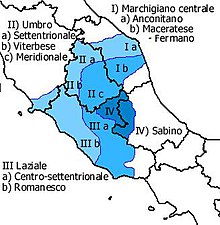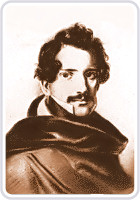lingvo.wikisort.org - Language
Romanesco (Italian pronunciation: [romaˈnesko]) is one of the central Italian dialects spoken in the Metropolitan City of Rome Capital, especially in the core city. It is linguistically close to Tuscan and Standard Italian, with some notable differences from these two. Rich in vivid expressions and sayings, Romanesco is used in a typical diglossic setting, mainly for informal/colloquial communication, with code-switching and translanguaging with the standard language.
This article needs additional citations for verification. (October 2007) |
| Romanesco | |
|---|---|
| Romano | |
| Native to | Italy |
| Region | Metropolitan City of Rome Capital, Lazio |
Language family | |
Writing system | Latin |
| Language codes | |
| ISO 639-3 | – |
| Glottolog | None |
| Linguasphere | 51-AAA-rab |
 | |

History

The medieval Roman dialect belonged to the southern family of Italian dialects, and was thus much closer to the Neapolitan language than to the Florentine.[1][2] A typical example of Romanesco of that period is Vita di Cola di Rienzo ("Life of Cola di Rienzo"), written by an anonymous Roman during the 14th century.[1] Starting with the 16th century, the Roman dialect underwent a stronger and stronger influence from the Tuscan dialect (from which modern Italian derives) starting with the reigns of the two Medici popes (Leo X and Clement VII) and with the Sack of Rome in 1527, two events which provoked a large immigration from Tuscany.[3][4] Therefore, current Romanesco has grammar and roots that are rather different from other dialects in Central Italy.[4]
The path towards a progressive Tuscanization of the dialect can be observed in the works of the major Romanesco writers and poets of the past two centuries: Giuseppe Gioachino Belli (1791–1863), whose sonetti romaneschi represent the most important work in this dialect and an eternal monument to 19th century Roman people; Cesare Pascarella (1858–1940); Giggi Zanazzo (1860–1911); and Carlo Alberto Salustri (1871–1950), nicknamed Trilussa.
Diffusion
Before Rome became the capital city of Italy, Romanesco was spoken only inside the walls of the city, while the little towns surrounding Rome had their own dialects. Nowadays, these dialects have been replaced with a variant of Romanesco, which therefore is now spoken in an area larger than the original one. It slightly pervades the everyday language of most of the immigrants who live in the large city.[citation needed]
Pronunciation

Romanesco pronunciation and spelling differs from Standard Italian in these cases:
- /j/ is used where standard Italian uses [ʎ]. This [j] is spelt ⟨j⟩, a letter no longer used in Italian. Compare Italian figlio [ˈfiʎʎo] "son" and Romanesco fijo [ˈfijo];
- geminate /r/ ("rolled r" or alveolar trill) does not exist anymore: for example, azzuro [aˈdːzuːɾo]; (Italian: azzurro "light blue"), verebbe [veˈɾebːe] (Italian: verrebbe "he/she would come").[5] A Roman pun recites: "Tera, chitara e guera, co' ddu' ere, sinnò è erore" (English: "Ground, guitar and war with two R's, otherwise there is a mistake"): note that ere and erore are also "wrong", as they are erre and errore in Standard Italian.[5] This phenomenon presumably developed after 1870, as it was not present in the classical 19th century Romanesco of Belli;[5]
- /l/ becomes /r/ before another consonant: sòrdi [ˈsɔrdi], Italian soldi "money";
- in Romanesco, as in most Central and Southern Italian languages and dialects, /b/ and /dʒ/ are always geminated where permissible: e.g. libbro [ˈlibːɾo] for Standard Italian libro [ˈliːbro] "book", aggenda for agenda "diary, agenda".
- the dropping of vowels at the beginning of a word when followed by a nasal consonant (m, n, gn), for example 'nzomma (Standard Italian insomma), 'n (Standard Italian un/in), 'mparà (Standard Italian imparare), gni (Standard Italian ogni).[6]
- assimilation with different consonant groups. (typically a Central-Southern phenomenon) For example, /nd/ turns into /nn/ (Standard Italian quando turns into quanno), /ld/ turns into /ll/ (Standard Italian caldo turns into callo), /mb/ turns into /mm/ (Standard Italian piombo turns into piommo).
Noteworthy figures
Today, Romanesco is generally considered more of a regional idiom than a true language. Classical Romanesco, which reached high literature with Giuseppe Gioachino Belli, has disappeared.
External forces such as immigration and the dominance of Italian are playing a role in the transformation.
Notable artists using Romanesco
This section of a biography of a living person needs additional citations for verification. (September 2014) |
- Ettore Petrolini, actor
- Elena Fabrizi, actor and cook
- Antonello Venditti, singer
- Aldo Fabrizi, actor and director
- Alberto Sordi, actor and director
- Nino Manfredi, actor
- Anna Magnani, actress
- Gabriella Ferri, singer
- Tomas Milian, actor
- Mario Brega, actor and comedian
- Gigi Proietti, actor, director and comedian
- Enrico Montesano, actor and comedian
- Carlo Verdone, actor and director
- Sabrina Ferilli, actress
- Trilussa, poet (Carlo Alberto Salustri's pen name)
- Giuseppe Gioacchino Belli, poet
- Cesare Pascarella, poet
- Lando Fiorini, actor and singer
- Franco Califano, lyricist, musician,
- Ferruccio Amendola, voice actor
- The anonymous writers of the Pasquinades posted on the talking statues of Rome use Italian, Romanesco or a mixture of both.[7]
See also
- Belli's The Sovrans of the Old World (1831)
References
- "La Parlata romana" (PDF). online.unistrasi.it. Università per stranieri di Siena. Archived from the original (PDF) on 6 February 2015. Retrieved 6 February 2015.
- "Romanesco". www.treccani.it. Treccani. Retrieved 6 February 2015.
- D'Achille, Paolo. "Italiano di Roma". www.treccani.it. Treccani. Retrieved 6 February 2015.
- "Dialetti". www.treccani.it. Treccani. Retrieved 6 February 2015.
- Ravaro 2005, p. 26
- Canepari, Luciano, Manuale di pronuncia italiana, Bologna, Zanichelli, 1998.
- Vidal, José Manuel (10 February 2017). "Pasquines contra Francisco, el Papa que atemoriza a los poderosos". Periodista Digital (in Spanish).
Sources
- Ravaro, Fernando (2005). Dizionario romanesco (in Italian). Roma: Newton Compton. ISBN 9788854117921.
External links
- A description of the Roman dialect
- (in Italian) Lucio Felici, Le vicende del dialetto romanesco, in "Capitolium", 1972 (XLVII), n° 4, pp. 26–33 (it is a summary of the history of Romanesco from the origin to nowadays).
На других языках
- [en] Romanesco dialect
[es] Romanesco (dialecto)
El romanesco o romanesque es una lengua regional o sociolecto del área de Roma. Pertenece al conjunto dialectal de italiano central y está relacionado al dialecto toscano y al italiano estándar.[it] Dialetto romanesco
Ciò che oggi s'intende con dialetto romanesco[1] è un codice linguistico molto simile all'italiano, tanto da essere considerato spesso più una "parlata" (un accento) che un dialetto.[2] Tipologicamente può essere considerato un dialetto nel senso anglo-francese, ma non nell'accezione italiana.[ru] Римский диалект
Ри́мский диале́кт (романеско; итал. Dialetto romanesco; транстеверинское наречие) отражает историческое развитие речи населения самого г. Рима и, таким образом, представляет собой продукт прямой эволюции народно-латинского языка в бывшей столице Римской империи при минимальных иноязычных влияниях субстрата и суперстрата.Другой контент может иметь иную лицензию. Перед использованием материалов сайта WikiSort.org внимательно изучите правила лицензирования конкретных элементов наполнения сайта.
WikiSort.org - проект по пересортировке и дополнению контента Википедии